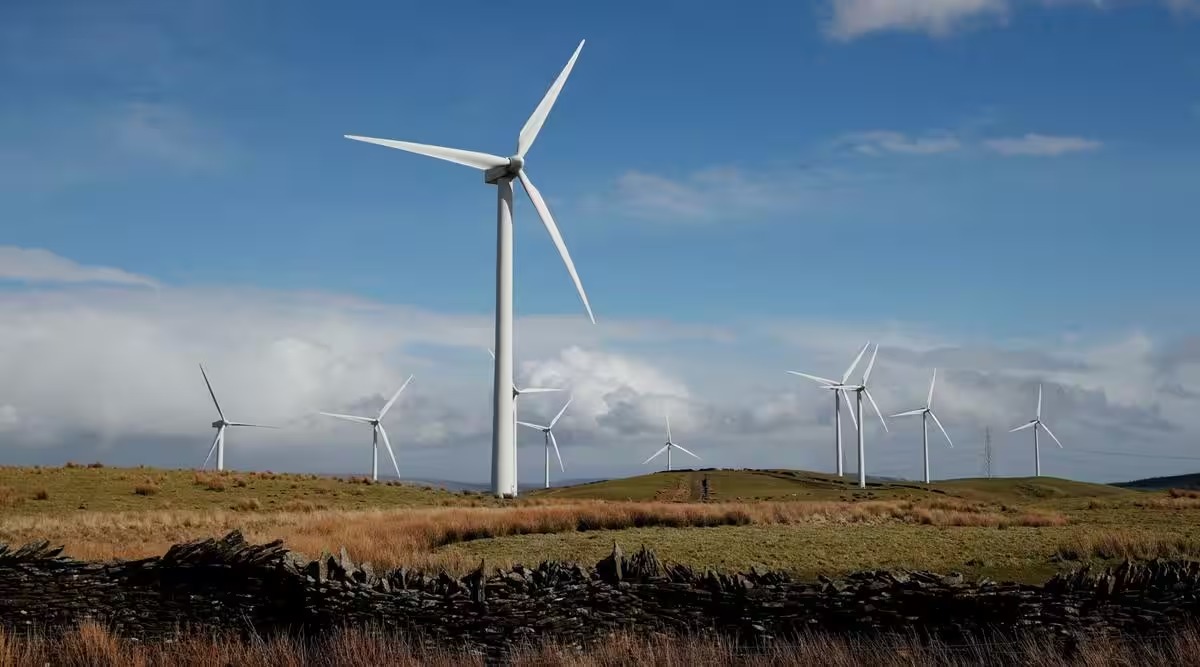Wind energy is a form of renewable energy that harnesses the kinetic energy from the wind and converts it into electricity. It is one of the fastest-growing sources of clean and sustainable power globally. Wind energy is primarily generated using wind turbines, which are large structures with rotating blades that capture the wind's energy and convert it into electrical power. Here's how wind energy works: Wind Turbines: Wind turbines consist of three main components - the tower, the blades, and the nacelle. The tower is a tall structure that supports the entire turbine. The blades are long and aerodynamically designed to capture the wind's energy. The nacelle is located behind the blades and houses the gearbox and generator. Wind Capture: As the wind blows, it impinges on the blades of the wind turbine, causing them to rotate. The aerodynamic design of the blades allows them to efficiently capture the wind's energy. Rotation and Generation: The rotation of the blades causes the shaft in the nacelle to spin. The gearbox increases the rotational speed, enabling the generator to produce electricity. The generator converts the mechanical energy from the spinning shaft into electrical energy. Power Transmission: The electricity generated by the wind turbine is typically in the form of alternating current (AC). It is transmitted through cables in the tower down to the base and connected to the grid for distribution to homes, businesses, and industries. Types of Wind Turbines: Horizontal-Axis Wind Turbines (HAWTs): HAWTs are the most common type of wind turbines. The blades rotate around a horizontal axis, perpendicular to the ground, resembling the propeller of an aircraft. Vertical-Axis Wind Turbines (VAWTs): VAWTs have blades that rotate around a vertical axis. These turbines are less common but have advantages in certain settings, such as urban environments or areas with turbulent winds. Benefits of Wind Energy: Renewable and Clean: Wind energy is a renewable resource as long as the wind keeps blowing, making it a sustainable alternative to fossil fuels. It produces no greenhouse gas emissions, helping to combat climate change and reduce air pollution. Energy Independence: Wind energy reduces dependence on finite and imported fossil fuels, enhancing energy security and resilience. Cost-Competitive: Wind energy has become increasingly cost-competitive, especially in favorable wind regions. The cost of wind power has decreased significantly over the past decade. Local Economic Development: Wind energy projects contribute to local economic development by creating jobs during construction, operation, and maintenance phases. Land Use Efficiency: Wind turbines can be installed on agricultural land, allowing farmers to continue using the land for farming and ranching while generating income from wind energy leases. Challenges and Considerations: Intermittency: Wind energy is intermittent and dependent on wind availability. Energy storage and grid integration solutions are essential to manage fluctuations in power output. Location Dependency: Wind energy requires suitable wind resources, and not all regions are well-suited for wind power generation. Visual and Environmental Impact: Large wind farms may have visual impacts on landscapes, and there may be concerns about potential effects on wildlife and birds. Noise: Some people living near wind farms have expressed concerns about noise generated by the turbines. Despite these challenges, wind energy remains a valuable and important renewable energy source, contributing significantly to global efforts to transition to a more sustainable and low-carbon energy future. Advances in technology, energy storage solutions, and continued support from governments and communities are likely to further enhance the role of wind energy in the global energy mix.
